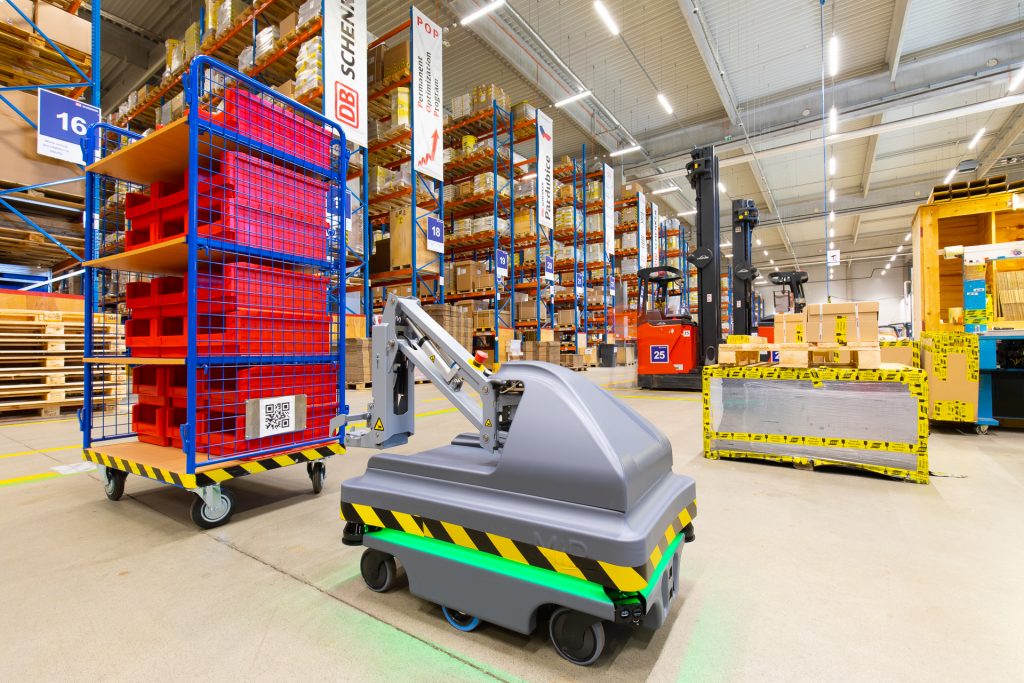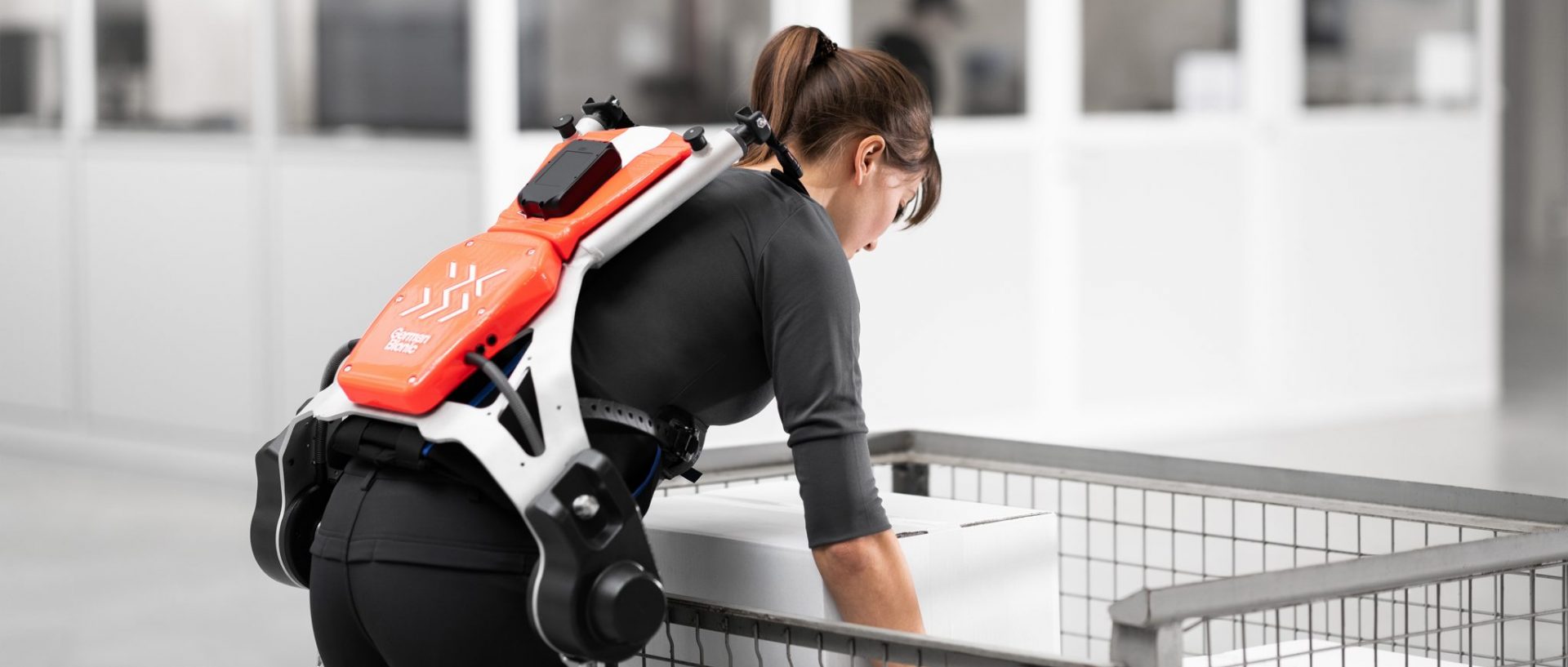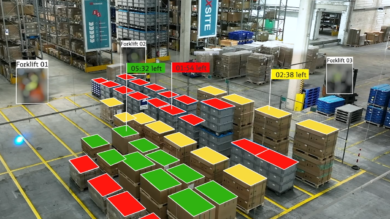Many years ago, warehouses were simply a place to store products ready to be sold or shipped. Throughout history, warehouses have continuously grown, developed and evolved to adapt to current trends and purposes. In the present day, warehousing has entered a new era – an era driven by technology, innovation and artificial intelligence (AI). A McKinsey study from 2019 showed that nearly half of all participants have at least one AI solution embedded at their organizations, while a further 30 percent were piloting the use of AI. When implemented successfully, these solutions have the potential to reduce costs, optimize operations and improve the overall efficiency of supply chains.
8 innovation and technology trends in modern warehousing

1. Automation and robotics
Automation and robotic technology have driven warehousing innovation in recent years. Many new warehouses are now built with a technology- and innovation-first approach – such as Red Lion, DB Schenker’s regional logistics hub in Singapore, where automation and robotics helped to increase productivity by up to 100 percent compared to manual processes.
DB Schenker was also one of the first logistics companies to implement the CarryPick automated storage and picking system from Swisslog for multiple customers at the same location in Sweden. The system mobilizes and automates entire sections of the warehouse to transport goods directly to staff for picking, thereby saving space and enabling faster processing times.
Another possibility is to integrate robotics, such as Automated Guided Vehicles or Autonomous Mobile Robots, into existing processes. When introduced in close collaboration with warehouse employees, robotics and automation have huge potential to increase efficiency and streamline supply chains.
2. Wearables
Recent innovations have caused a surge in the implementation of wearables and smart picking technology in warehousing processes. Devices such as exoskeletons, scanning glasses and picking gloves can boost productivity and ease workload, allowing employees to dedicate their time to more rewarding, higher-value tasks. During the COVID-19 pandemic, DB Schenker implemented social distancing wearables in logistics operations in Neu-Isenburg, Germany, in order to keep employees safe while ensuring business continuity. To ensure widespread use of wearable technology in the future, logistics companies should focus on ease-of-use, holistic integration and return on investment.

3. Warehouse management systems
Warehouse management systems (WMS) consist of software and processes to control and optimize warehouse operations – in other words, the central control center of the warehouse. Designed to improve efficiency along the supply chain, WMS have huge potential to save costs, improve accuracy, increase throughput and provide inventory visibility at all times – which can be extremely beneficial to customers. DB Schenker uses next generation WMS at many locations worldwide, including Red Lion in Singapore. Here, the software connects various automations in operation, enabling the site to run efficiently. As a result, lead time for customers is reduced by 40 percent compared to non-integrated facilities.
4. Internet of Things
Internet of Things (IoT) is increasingly used in the logistics industry to track and collect data from cargo in transit, such as high-value or temperature-sensitive goods. Although not as widespread, IoT is also gaining momentum in contract logistics, with focused technology and innovations now being developed specifically for warehouse operations. Various use cases include cold chain storage of goods or ensuring uptime and productivity of automated equipment such as robots. There are many benefits associated with converting warehouse equipment and processes to smart technology, such as improved transparency, reduced downtime of equipment via predictive maintenance, real-time product tracking and higher employee productivity – thanks to instant, on-demand assistance.
5. Cloud-based technology
Cloud-based analytics software is often used in combination with IoT to retrieve data from smart equipment, such as autonomous robots or temperature sensors. Once the data reaches the cloud, it can be filtered, organized and analyzed to provide meaningful information to other applications or warehouse employees. Many WMS are now cloud-based, in order to allow scalability of operations, enhanced cyber security and the possibility to connect multiple systems, among other advantages. E-commerce and omnichannel customers in particular can benefit from cloud-based WMS, due to the possibility to work around the clock without disruptions or downtime.
6. Drones
Elsewhere in the logistics industry, drones are being tested for last-mile deliveries, with the promise of fast, cost-efficient and sustainable shipments. However, drone technology and innovations can also be used in warehouse operations – for example, in the area of inventory management. Here, drones can perform tasks such as inventory audit, cycle counting, item searches, buffer stock maintenance and stock taking. Particularly in large warehouses with high storage shelves, using a drone for these tasks can save time and increase employee safety, allowing warehouse workers to focus their time on other tasks.
7. Virtual reality
Virtual reality technology can be used by logistics companies to train warehouse employees in essential tasks, such as order picking and packing, or driving a forklift truck. Together with Fraunhofer IML, DB Schenker developed various virtual training applications in a dedicated innovation lab. The virtual environment provides a safe but realistic setting and has led to increased efficiency and higher success rates in training. Virtual reality can also be used to give remote warehouse tours, providing a more sustainable way for customers and employees to visit and interact with warehouses around the world.
8. 3D printing
Innovations in 3D printing technology have the potential to revolutionize warehousing as we know it, particularly in the production and storage of spare parts. Instead of supporting after-sales maintenance and repair from a centralized location, spare parts can be produced onsite via 3D printing technology. By digitalizing and de-centralizing the production process, production times can be shortened and supply chains optimized. 3D printing also has the potential to save space and money by reducing the need for inventory requirements, since items can be produced as and when they are needed.
As the above warehousing examples demonstrate, innovation is more than just technology. To be truly innovative and drive long-term success, logistics companies must integrate technology holistically – with a focus on clear benefits in increasing efficiency and boosting productivity. This holistic approach should be built into business strategies as the basis of all operations. In fact, a McKinsey study showed that 43 percent of participants believed a lack of clear strategy was the biggest barrier to implementing Artificial Intelligence (AI) and innovative technology at their organizations.
To drive long-term success, all stakeholders must be on board – from CEOs to warehouse managers and, most importantly, warehouse employees. It is essential that everyone understands the value and benefits – both to the company and to individuals – of innovation and technology in warehousing processes. On an individual level, for example, warehouse employees can benefit by having more time to focus on more rewarding, higher-value tasks – resulting in an improved quality of daily work. Once the benefits are clear, adoption and implementation should be smooth, resulting in technology-driven warehouse operations and an innovation-first, future-ready company.
Published: April 2021










